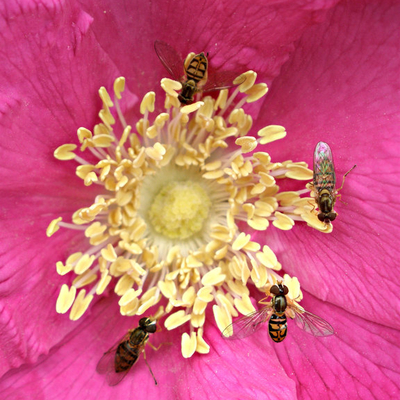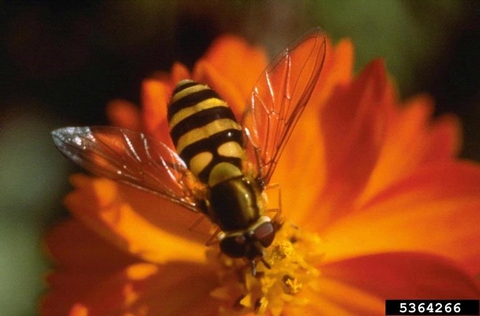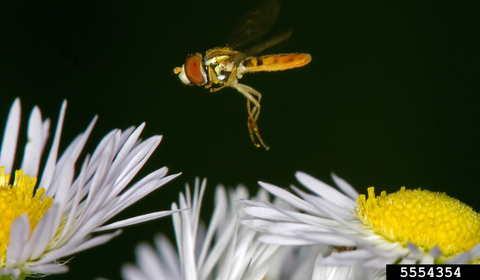Quick facts
- Syrphid flies are also known as hover or flower flies.
- Some adult flies can mimic bees.
- The larval stage is an important early and late-season aphid predator. A single larva can feed on dozens of aphids a day.
How to tell syrphid flies from other insects
Adults
- Adults are similar in size and color to wasps and bees. They mimic these insects as a form of protection from predators.
- Syrphid flies do not bite or sting.
- You can tell syrphid flies apart from wasps and bees by looking closely at the wings. You will only see one pair of wings, while wasps and bees have two pairs.
- Adults have large eyes.
- Adults are quick and agile fliers and are often seen near flowers.
Larvae
- Larvae can be green, yellow or brown.
- Larvae look like slugs or caterpillars and have a tapered body.
- They are very active, moving around plants in search of prey.
Biology
- Different species spend the winter in different ways. Most spend the winter in protected areas, like leaf piles or brush, as pupae or larvae.
- Eggs are laid near a food source, and are most often seen near large groups of aphids. The eggs resemble a grain of rice.
- Larvae hatch and feed on aphids. Depending on the species, they eat 100 to 400 aphids.
- Adults emerge and feed on nectar or pollen.
Promoting syrphid flies in gardens and farms
To support syrphid flies in your yard, garden, or farm, think about ways to provide them with a variety of food and habitat.
- Have consistently flowering plants in your space. Providing season-long food sources will encourage many beneficial insects to be in your garden. They especially love white, compound flowers.
- Allow some level of pests in the garden.
- Syrphid flies do not fly in windy conditions. Windbreaks can protect plants and provide important habitat for syrphid flies and other beneficial insects.
- Flowering cover crops attract and support adult syrphid flies.
- Limit pesticide applications. Many insecticides are not selective, meaning they will kill pests, beneficial insects, and other insects. If you plan on using an insecticide, look for a selective insecticide.
Bugg, R. L., Golfer, R., Chaney, W., Smith, H., & Cannon, J. (2008). Flower flies (Syrphidae) and other biological control agents for aphids in vegetable crops. University of California, Division of Agriculture and Natural Resources.
Cranshaw, W. &; Shetlar, D. J. (2018). Garden Insects of North America: The Ultimate Guide to Backyard Bugs. Princeton University Press.
Skevington, J. H., Locke, M., Young, A., Moran, K., & Crins, W. (2019). Field guide to the flower flies of Northeastern North America. Princeton University Press.
UC Statewide IPM Program (UC IPM). Syrphids (Flower Flies, or Hover Flies). Syrphids (Flower Flies, or Hover Flies). https://www2.ipm.ucanr.edu/natural-enemies/syrphids/
Reviewed in 2023





